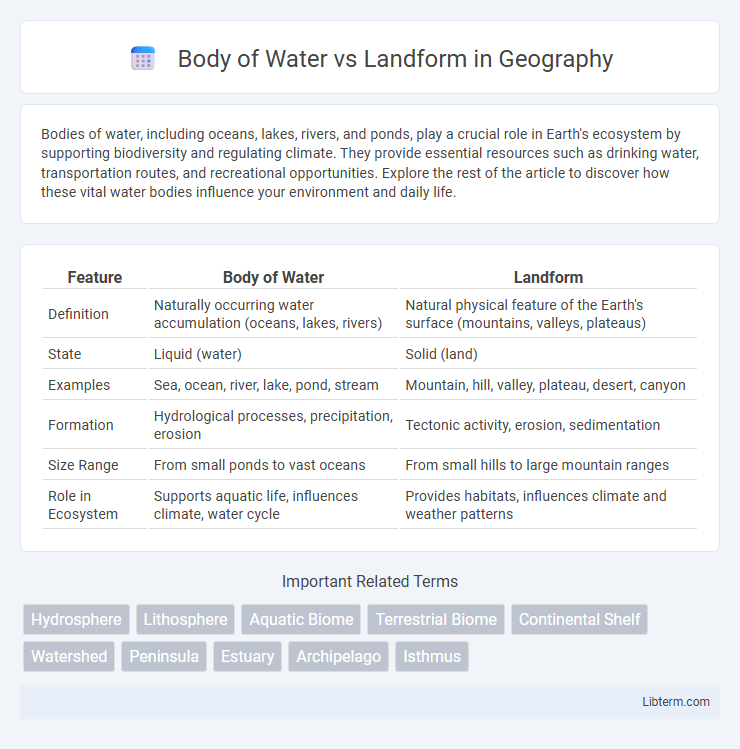Bodies of water, including oceans, lakes, rivers, and ponds, play a crucial role in Earth's ecosystem by supporting biodiversity and regulating climate. They provide essential resources such as drinking water, transportation routes, and recreational opportunities. Explore the rest of the article to discover how these vital water bodies influence your environment and daily life.
Table of Comparison
| Feature | Body of Water | Landform |
|---|---|---|
| Definition | Naturally occurring water accumulation (oceans, lakes, rivers) | Natural physical feature of the Earth's surface (mountains, valleys, plateaus) |
| State | Liquid (water) | Solid (land) |
| Examples | Sea, ocean, river, lake, pond, stream | Mountain, hill, valley, plateau, desert, canyon |
| Formation | Hydrological processes, precipitation, erosion | Tectonic activity, erosion, sedimentation |
| Size Range | From small ponds to vast oceans | From small hills to large mountain ranges |
| Role in Ecosystem | Supports aquatic life, influences climate, water cycle | Provides habitats, influences climate and weather patterns |
Definition of Body of Water
A body of water is a significant accumulation of water, such as oceans, seas, lakes, rivers, and ponds, clearly defined by their liquid state and hydrological characteristics. Unlike landforms, which are physical features of the Earth's surface like mountains, valleys, and plateaus, bodies of water are distinguished by their aquatic environments supporting diverse ecosystems. Understanding the definition of bodies of water is crucial for geography, environmental science, and resource management.
Definition of Landform
A landform is a natural physical feature on the Earth's surface, such as mountains, valleys, plateaus, and hills, formed by geological processes including tectonic activity, erosion, and sediment deposition. Unlike bodies of water, which are defined by accumulations of water like lakes, rivers, and oceans, landforms consist primarily of solid earth materials. Understanding the definition of landforms is crucial for geographical classification, environmental studies, and land use planning.
Key Differences Between Bodies of Water and Landforms
Bodies of water include oceans, lakes, rivers, and seas, characterized by the presence of liquid water, whereas landforms are natural physical features of the Earth's surface such as mountains, valleys, plateaus, and deserts. Bodies of water serve as habitats for aquatic life and influence climate, while landforms shape ecosystems, weather patterns, and human settlement. Key differences lie in composition--water versus solid earth--and their role in the environment and geography.
Types of Bodies of Water
Types of bodies of water include oceans, seas, rivers, lakes, ponds, and wetlands, each distinguished by size, salinity, and freshwater content. Oceans represent the largest saltwater bodies covering over 70% of Earth's surface, while lakes and ponds are inland bodies of freshwater varying in depth and area. Rivers function as flowing watercourses that drain into seas or lakes, and wetlands serve as transitional ecosystems between terrestrial and aquatic environments.
Types of Landforms
Landforms are natural physical features on the Earth's surface, including mountains, valleys, plateaus, and plains, which differ significantly from bodies of water such as lakes, rivers, and oceans. Mountains are elevated landforms with steep slopes, while valleys are low areas between hills or mountains, often with a river running through them. Plateaus are flat-topped elevated areas, and plains are vast stretches of flat or gently rolling land ideal for agriculture and settlement.
Formation Processes: Water vs Land
Bodies of water form through processes such as erosion, sediment deposition, tectonic activity, and glacial melting, creating lakes, rivers, seas, and oceans. In contrast, landforms develop from volcanic activity, mountain building through plate tectonics, weathering, and erosion of rock and soil. While water bodies result mainly from fluid dynamics and sediment transport, landforms emerge from solid earth processes shaping the terrain.
Ecological Roles and Importance
Bodies of water such as lakes, rivers, and oceans play vital ecological roles by supporting aquatic biodiversity, regulating climate through water cycles, and providing habitats for countless species. Landforms, including mountains, valleys, and plains, influence atmospheric patterns, soil formation, and terrestrial ecosystems by shaping nutrient distribution and water runoff. Both bodies of water and landforms are essential for maintaining ecological balance, supporting food chains, and sustaining the Earth's biodiversity.
Human Interaction and Utilization
Bodies of water such as rivers and lakes serve as vital resources for human settlements, providing drinking water, transportation routes, and fishing opportunities. Landforms like mountains and plains influence agriculture, urban development, and resource extraction by determining soil fertility, climate, and accessibility. Human interaction with these natural features drives economic activities and shapes cultural practices based on the availability and characteristics of water bodies and landforms.
Famous Examples Around the World
The Great Barrier Reef represents a renowned body of water characterized by its extensive coral ecosystem, while the Grand Canyon exemplifies a famous landform carved by millions of years of erosion. The Dead Sea serves as an iconic saline body of water bordered by Jordan and Israel, contrasting with Mount Everest, the highest landform peak on Earth located in the Himalayas. Bodies of water like Lake Baikal, the deepest freshwater lake in Siberia, differ significantly from landforms such as the Sahara Desert, the largest hot desert spanning North Africa.
Conservation Challenges and Solutions
Body of water ecosystems face conservation challenges such as pollution, habitat destruction, and invasive species, requiring targeted water quality management and restoration efforts. Landforms encounter soil erosion, deforestation, and urbanization, necessitating sustainable land use practices and reforestation projects to preserve natural habitats. Both bodies of water and landforms benefit from integrated conservation strategies, including protected areas, community engagement, and climate change mitigation to ensure ecosystem resilience.
Body of Water Infographic

 libterm.com
libterm.com